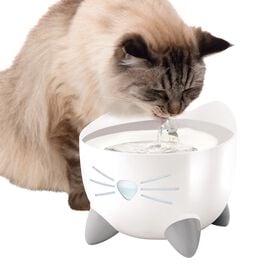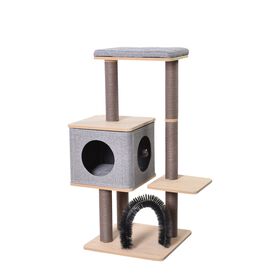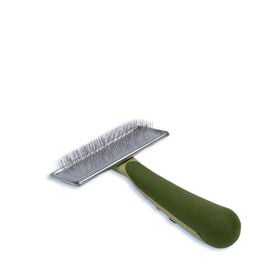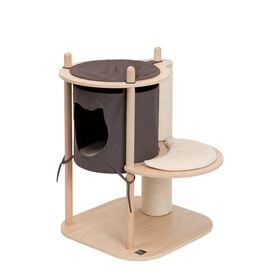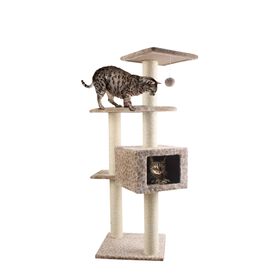The skogkatt, also known as a Norwegian forest cat, is what is referred to as a natural breed. This means that the breed developed through the natural selection of individuals based on their environmental conditions rather than by human intervention.
Origins of the Norwegian forest cat
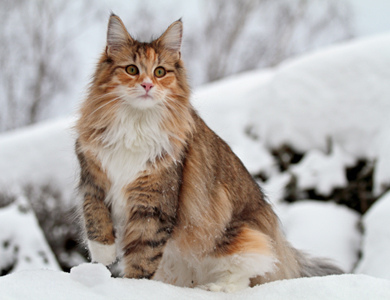
The Vikings may have first imported cats from the Middle East to Norway. Other long-haired cats may also have been brought from Europe during the first crusades, and possibly also from Russia and Turkey.
Since Norway has a cold, harsh climate and is remote and isolated, which limits genetic possibilities, skogkatts needed adapted characteristics to survive and reproduce. The most highly adapted cats intermingled naturally until a particular breed of cat with specific and reproducible characteristics emerged. The skogkatt was born. For several centuries, the breed was present in Norway, without too many changes to its appearance.
In the early 20th century, people began to take an interest in this local breed and to control its numbers somewhat because it was threatening to disappear in favour of stray, domestic, short-haired cats that were increasingly present in Norway. After the Second World War, Norwegian breeders went in search of semi-wild cats with the specific characteristics of traditional Norwegian cats. These species replaced the Norwegian forest cats and became the official cat breed of Norway.
Appearance of the Norwegian forest cat
In terms of appearance, a Norwegian forest cat could be mistaken for a domestic long-haired cat or possibly a Maine Coon. On closer observation, however, it is clear that the skogkatt has unique features, since it is built for hunting, climbing and living in cold, harsh conditions.
The Norwegian forest cat has a sturdy, rather rectangular structure, long legs, good muscle tone and a solid bone structure. Its tail, which is as long as its body, is very bushy. The cat’s head is shaped like an equilateral triangle and it has a heart-shaped ruff around the neck. What distinguishes it most from other cats is the facial profile, which is straight from the brow ridge to the tip of the nose. Its large, slightly oblique, almond-shaped eyes give it a gentle, expressive look.
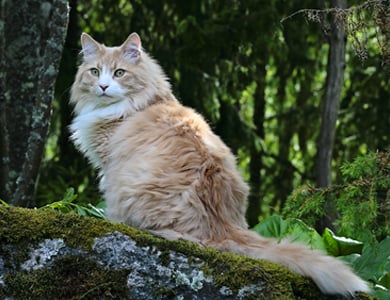
The males are larger than the females, easily reaching 5 to 7 kg (12 to 15 lb.). The main feature of the Norwegian forest cat is undoubtedly its double coat, which protects it from the nastiest weather. The semi-long, thick and highly water-repellent coat covers a dense, woolly undercoat. Consistent with the cat’s ability to adapt, the Norwegian forest cat’s fur is different in summer. It is a bit shorter and less dense, but just as water-repellent. This very special coat can be any of the colours that cats come in, with the exception of the colourpoint colours.
Is this the good breed for your family?
Skogkatt behavior
This cat generally adapts well to all types of households, provided it is given time and its environment has plenty of cat trees and tall scratching posts. A mostly placid animal, it has moments of intense activity interspersed with long periods of rest. Skogkatts are said to be very attentive to their surroundings.
Norwegian forest cats can have all types of personality traits, but it is important to realize that they are adapted to a rugged existence and survival under difficult conditions. Your environment should therefore correspond to this type of lifestyle.
Regular maintenance
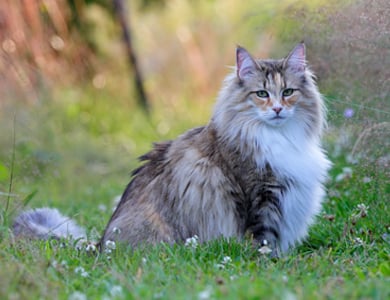
The skogkatt’s long coat is surprisingly low maintenance. One brushing a week is usually enough. When seasons change, however, especially in spring, moulting is particularly impressive. Then they have to be brushed almost daily to remove dead hair and keep them from developing knots.
Did you know?
- The skogkatt is a breed that is slow to grow, generally reaching its full physical maturity only toward age 5.
- The Vikings used these sturdy cats to control vermin on their ships, as well as in their villages. It is therefore quite likely that they brought some with them to America, at the time of the voyages of Leif Erickson and his contemporaries. Some people believe that the skogkatt may have been the ancestor of the Maine coon cat, but there is no genetic link to confirm this.


